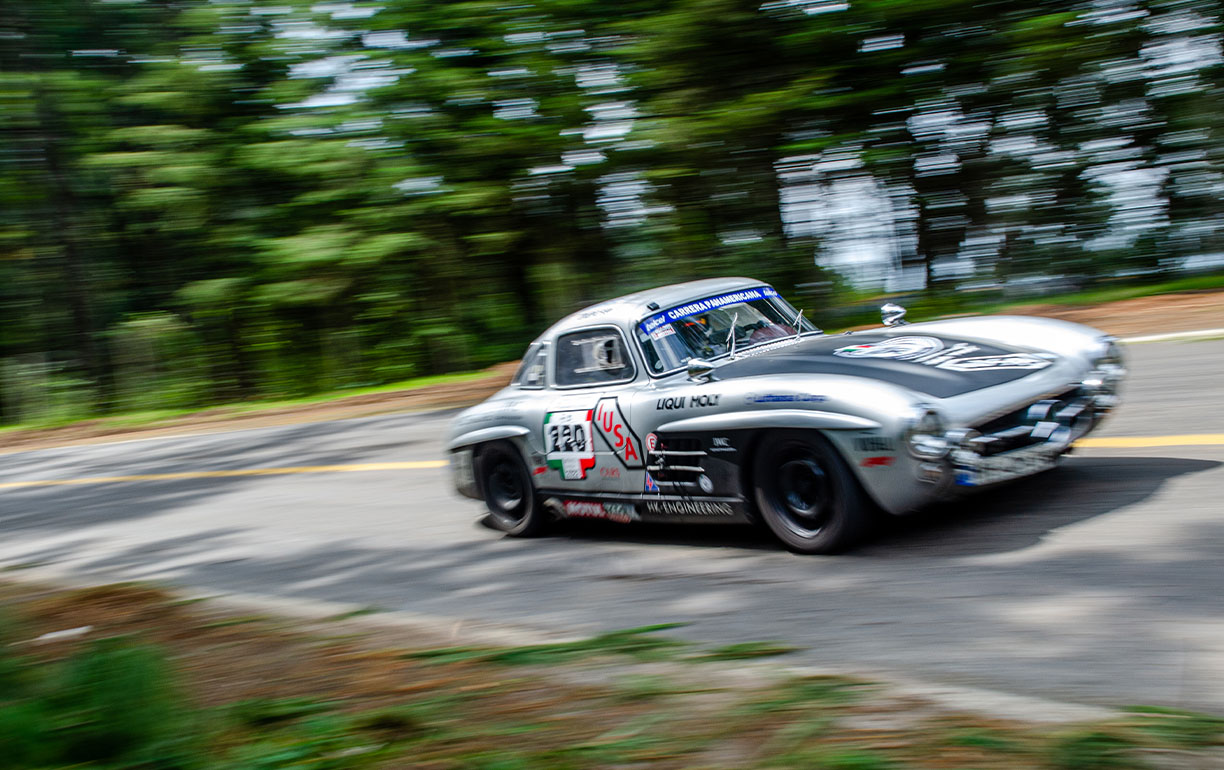
Zeitreise mit Lufthansa Cargo: Ein Flügeltürer fliegt ins Abenteuer
Mit dem Mercedes 300 SL bei der Carrera Panamericana 2022
Ein handgemaltes Plakat, ein silberner Rennsportwagen auf einer Staubpiste, im Hintergrund ein riesiger Kaktus. Als Überschrift nur zwei Worte: "Triumphaler Doppelsieg" und dann zwei Namen: 1. Karl Kling, 2. Hermann Lang. Mehr braucht es nicht für die Geburt einer Legende: Der Mercedes 300 SL und die von ihm abgeleitete Straßenversion werden Automobilgeschichte schreiben – als Mercedes "Flügeltürer". Eine Geschichte, die auf der Rennstrecke der Carrera Panamericana 1952 beginnt. Und die 70 Jahre später immer noch nicht zu Ende ist.
|
2022, Veracruz, Mexiko. Der nahezu ungedämpfte Schall klassischer Rennmotoren dröhnt in den Ohren. Wir sehen historische Porsches, einen Ferrari, einen Jaguar. Doch die Menge hat nur Augen für den silbernen Wagen mit der Startnummer 220: Einen Mercedes 300 SL Flügeltürer. Die Legende ist wieder da. 70 Jahre nach dem großen Triumph geht sie bei der 35. Auflage des Rennens an den Start. Möglich gemacht hat das ein Mann, der übernächtigt, aber lächelnd neben dem Auto steht und sich bereit macht für den Start. Der von Pontius bis Pilatus gelaufen ist, um Sponsoren zu finden für seinen Traum. Der vor einer Stunde noch nicht wusste, ob dieser Traum in Erfüllung oder in Trümmer gehen würde. Und der das Glück hatte, mit Lufthansa Cargo einen Partner zu finden, der Zeitreisen ermöglichen und Rennen gegen die Zeit gewinnen kann. Es ist die Geschichte von Kurt Richter, dem Träumer, dem Macher und dem Rennfahrer. Und von Lufthansa Cargo, die als Möglichmacher gezeigt haben, was "just in time" manchmal auch bedeuten kann ... |
Rückblende. Schon seit Jahren pflegt Kurt Richter, mexikanischer Hobby-Rennfahrer mit deutschen Wurzeln, eine enge Beziehung zu Mercedes Flügeltürern. Bereits bei früheren Auflagen der Carrera Panamericana hat er die Fahrzeuge als Mechaniker betreut, kennt ihre Stärken, ihre (wenigen) Macken und natürlich ihre Geschichte, die in Mexiko vielleicht sogar noch präsenter ist als in Deutschland. Und 2021, als Besucher der mittlerweile wiederbelebten Panamericana, reift in ihm ein Plan: Wenn sich der große Erfolg von 1952 zum 70. Mal jährt, dann muss doch eigentlich ein Flügeltürer an der Startlinie stehen. Um genau die Strecke unter die Reifen zu nehmen, die die Rennsportabteilung von Mercedes nach dem Zweiten Weltkrieg endgültig wieder auf die Siegerstraße brachte ...
|
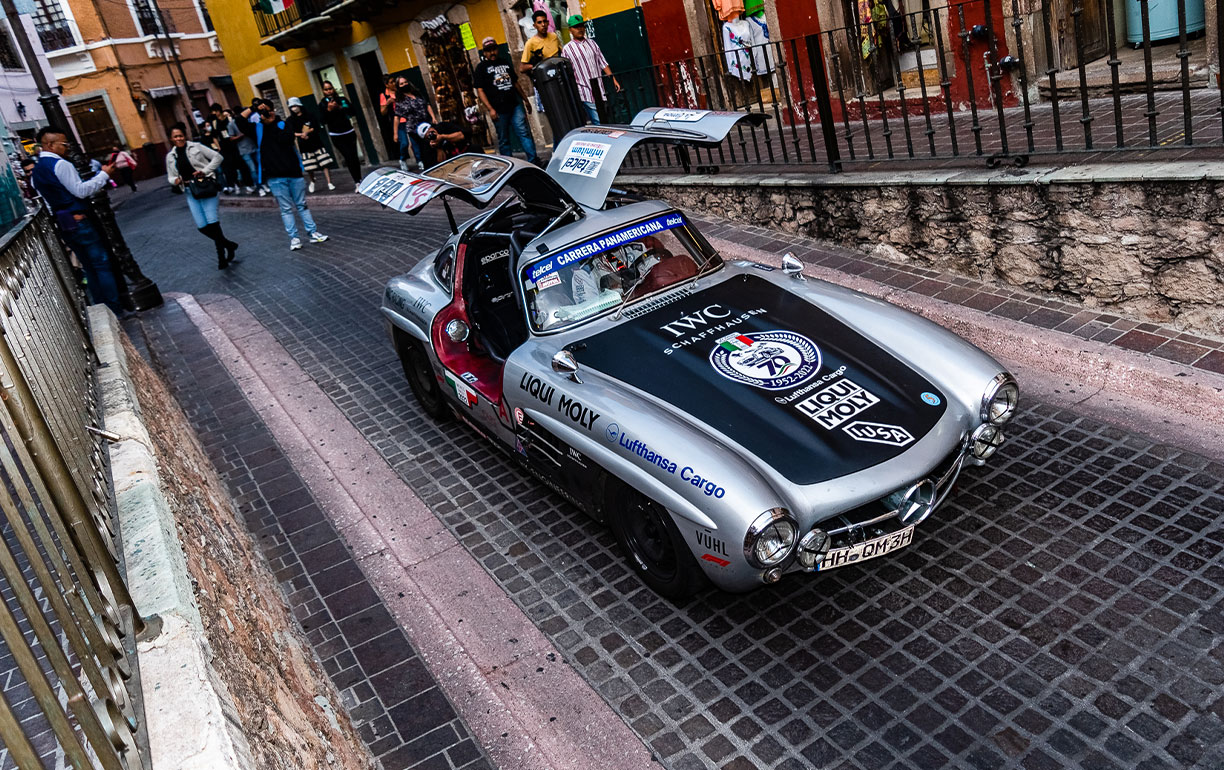
"Ich wollte dieses Auto wieder zurück zu den Menschen in Mexiko bringen – unbedingt!"
Schlaglöcher, staubige Pisten. Hitze. Mexiko, November 1952. Das erste Jahr, in dem Mercedes sich nach dem Krieg wieder an Rennen beteiligt, neigt sich dem Ende zu, und es hatte bereits einige Erfolge mit dem neuen Rennsportwagen, dem 300 SL gegeben: Doppelsieg in Le Mans, die drei ersten Plätze beim Eifelrennen auf dem Nürburgring. Doch das waren echte Rennstrecken gewesen, Kurse, die man kannte oder die man sich zumindest schnell einprägen konnte. Aber das hier ist etwas völlig anderes: Tausende von Kilometern auf öffentlichen Straßen, schlechter Belag, dazu enorme Höhen- und Temperaturunterschiede. Wer hier das erste Mal startet, ist Außenseiter. Kommt her, um zu lernen. Schon allein deshalb gehören den Deutschen die Sympathien der Mexikaner. Und auch, weil die Alemanos ein paar komische Eigenheiten an den Tag legen: Sie fahren die Tagesstrecken vorher ab und schreiben sich jede Passage, jede Kurve, jedes Nadelöhr fein säuberlich in ein Buch. Die Konkurrenz belächelt das.
|
Doch was damals noch keiner weiß: Diese Panamericana ist vermutlich auch die Geburtsstunde des so genannten "Gebetbuches" – aus dem der Beifahrer dem Piloten genau ansagt, was als nächstes kommt. "300 Meter, 60 Grad links, 50, zweiter Gang, dann Gerade, vierter Gang, 180, ..." Heute wird bei jeder Rallye so gefahren. 1952 hat diese Idee dem Mercedes-Team wertvolle Zeit gebracht und war einer der ganz wichtigen Eckpfeiler des Sieges ... Im Gebetbuch von Kurt Richter steht erstmal etwas ganz anders – nämlich eine ungeheure Summe Geld, die nötig ist, um das Auto auch wirklich starten zu lassen. Die andere Hürde, nämlich überhaupt einen für Rennen zugelassenen 300 SL zu finden, ist für Richter schnell genommen: Zu HK Engineering aus dem bayrischen Polling pflegt er enge Beziehungen und hat dadurch Zugriff auf einen 300 SL, der seit 15 Jahren erfolgreich bei historischen Rennen mitmischt. Aber Rennsport ist nun mal eine teure Sache, am anderen Ende der Welt noch mehr – und erst Recht, wenn der Marktwert des Fahrzeugs bei konservativ geschätzten 1,5 Millionen liegt. Und so beginnt für Kurt Richter ein Etappenrennen der ganz anderen Art, bei dem es weniger um Geschwindigkeit, sondern vielmehr um Geduld geht: die Suche nach Sponsoren. |
Und alle, die in Frage kommen, winken ab. Vertrösten. Wollen erst einsteigen, wenn klar ist, dass der Wagen auch wirklich den Weg nach Mexiko findet. "Bring erstmal einen Flügeltürer her, dann sehen wir weiter." Währenddessen tickt die Uhr, verstreicht die Zeit. Das Jahr 2022 bricht an. Es wird Frühjahr. Es wird Sommer. Kurt Richter kommt einfach keinen Schritt voran. Und dann schreibt er eine Mail. Der Inhalt: Die Geschichte des Rennens. Das Jubiläum. Die Idee. Und die Info, dass der Wagen nicht das Problem ist. Der Empfänger: Frank Nozinsky. Director von Lufthansa Cargo für den mittelamerikanischen Raum. Sitz: Mexico-City. Es ist mittlerweile der 25. August, ein Donnerstag. Dass die Cargo schnell ist, weiß Richter. Wie schnell, überrascht ihn dann aber doch: Schon am Montag erhält er die Antwort: "Zeit für einen Teams-Call? Ich lade die Zentrale gleich mit ein." "Ich habe Kurts Anfrage gesehen und sofort gedacht: Wenn das nicht Enabling Global Business ist – was dann?"
|
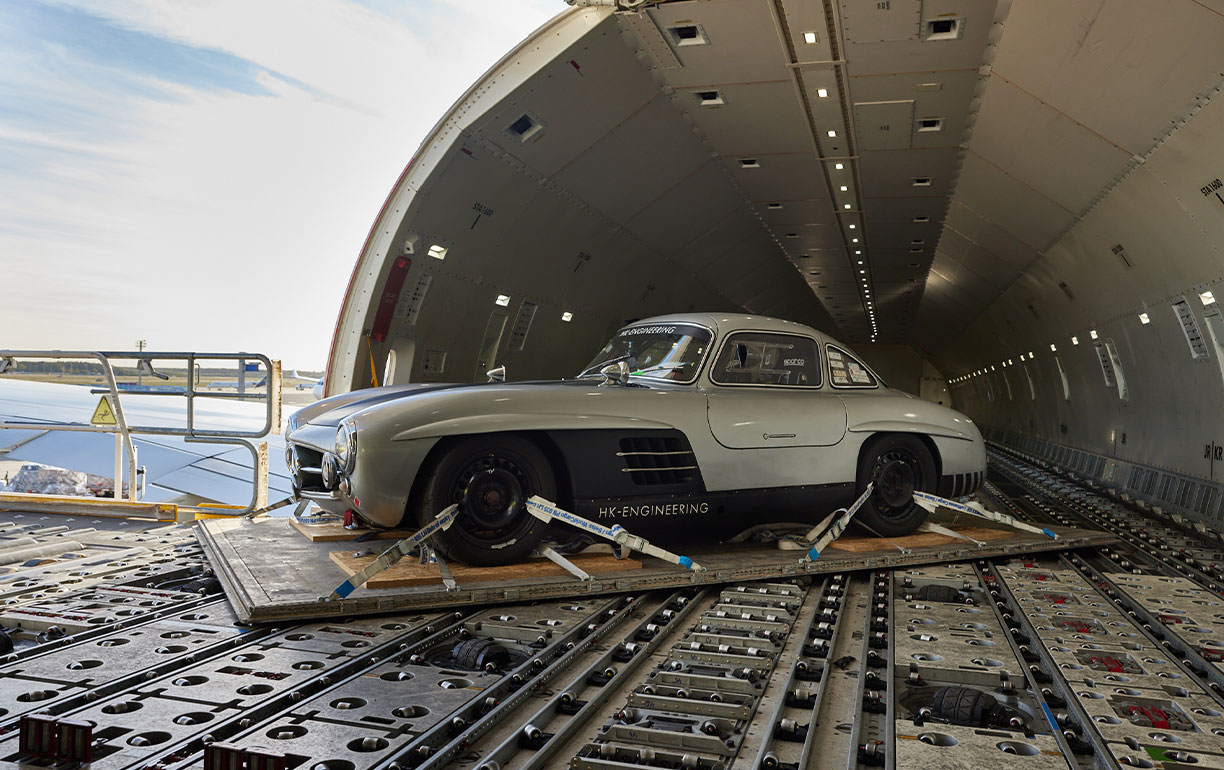
Nicht nur die schnelle Rückmeldung sorgt bei Kurt Richter für neue Hoffnung – er weiß auch, dass er mit Lufthansa Cargo auf echte Profis in Sachen Autotransport setzt. Kaum jemand transportiert so viele wertvolle Autos oder wichtige Ersatzteile durch die Luft wie Lufthansa Cargo. Und kaum jemand verfügt über so viel Erfahrung mit automobilen Raritäten, hat so gut geschultes Personal vor Ort und für Güter dieser Art – Valuable Goods – spezielle und besonders umsichtige Prozesse etabliert. Noch in der gleichen Woche findet der erste Call statt. Die Botschaft an Kurt Richter ist so klar wie ermutigend: Wir helfen dir. Wir übernehmen den Transport.
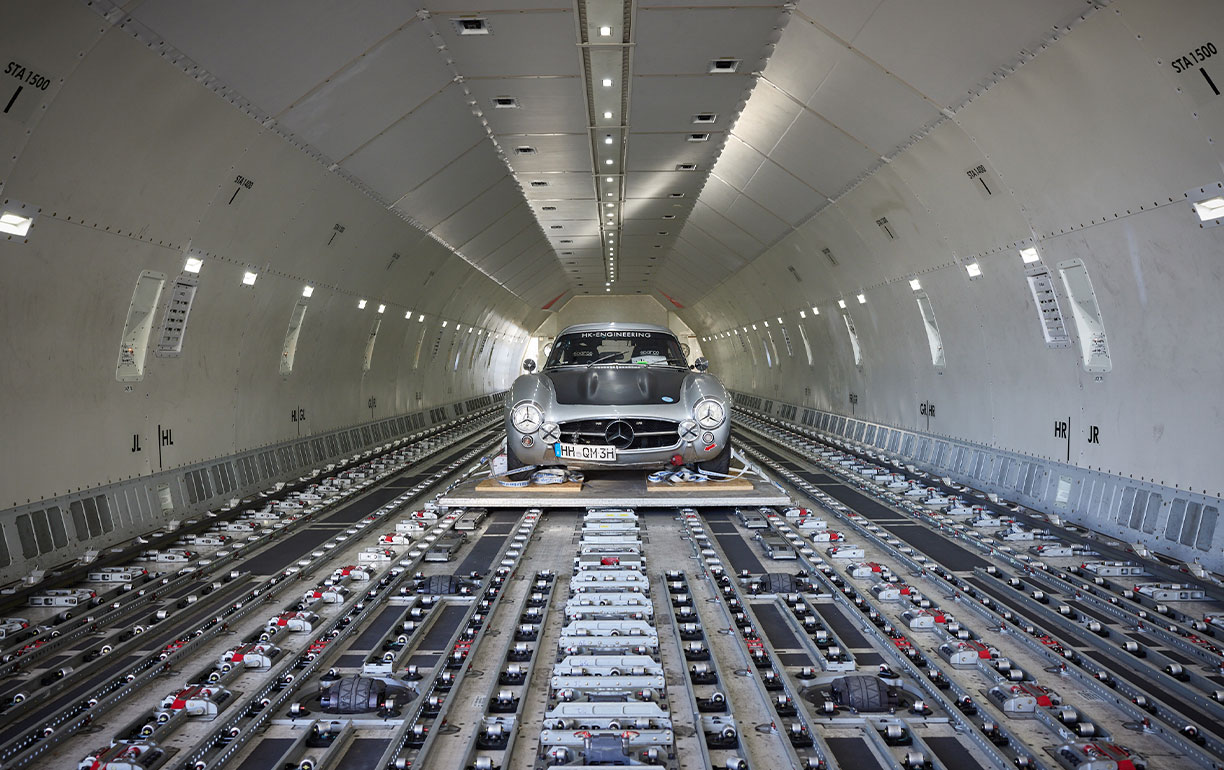
Das Eis ist gebrochen. Jetzt wollen plötzlich andere auch mitmachen. Sagen zu. Versprechen finanzielle Unterstützung. Aber bis das Geld bei Richter eintrifft, vergeht weitere wertvolle Zeit. Der Start zur Carrera Panamericana ist am 14. Oktober. Und erst am 23. September hat Kurt Richter das Geld aller Sponsoren auch wirklich zur Verfügung. Gibt das Go an HK Engineering: Macht den Wagen fertig. Das Rennen vor dem Rennen beginnt. Denn der Wagen muss höhergelegt werden. Braucht eine andere Bremsanlage. Weil in Mexiko immer noch andere Straßenverhältnisse herrschen als auf europäischen Rennstrecken ...
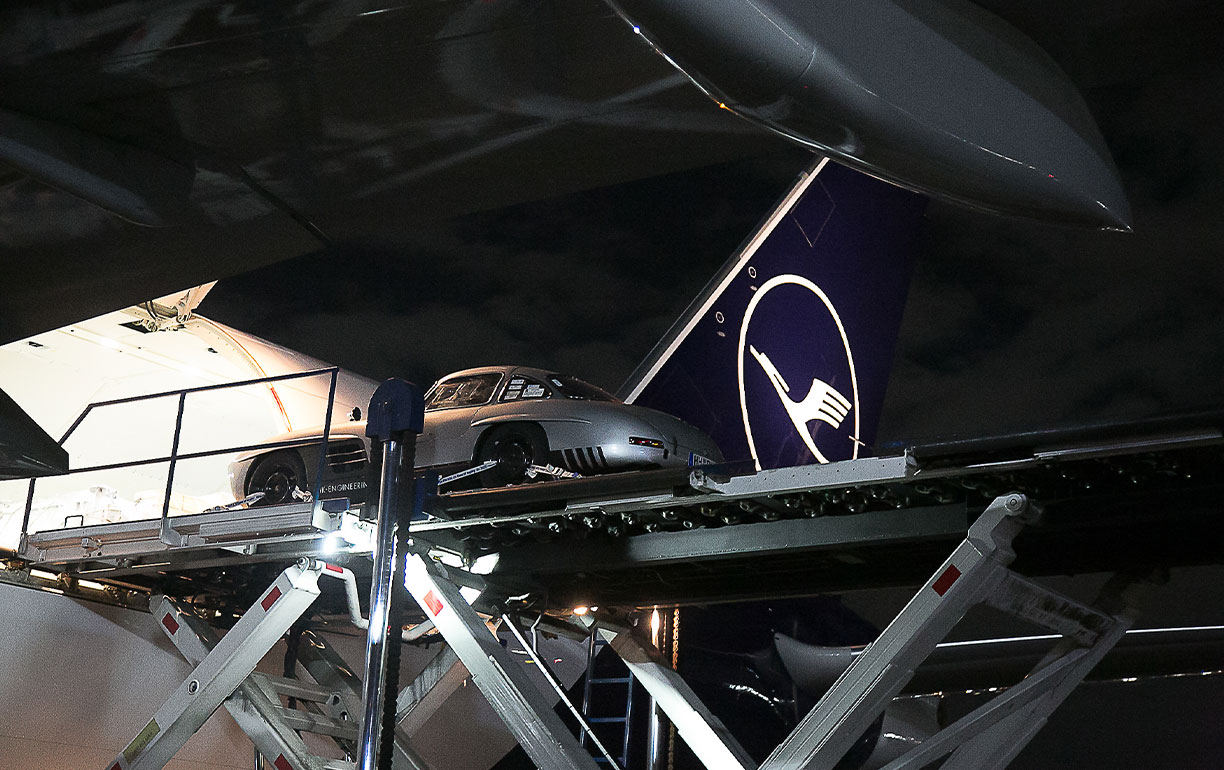
Irgendwo zwischen Tuxtla und Oaxaca in Südmexiko. Der erste Renntag. Mit fast 200 Stundenkilometern rast das silberfarbene Leichtgewicht die schmale Piste entlang. Der Mann am Steuer lauscht den Ansagen aus dem Gebetbuch. Zirkelt den Wagen mit einem für heutige Verhältnisse riesigen Lenkrad millimetergenau um die Kurven. Reagiert präzise auf jedes Ausbrechen, jede Unebenheit. Und hat dann doch keine Chance: Mit voller Wucht prallt ein riesiger Geier in die Windschutzscheibe. Glas splittert. Mit Mühe hält der Fahrer den Wagen auf der Piste. Schaut zur Seite. Sein Beifahrer ist blutüberströmt. Bewusstlos. Es dauert eine gefühlte Ewigkeit, bis er wieder zu sich kommt – und auf sofortiger Weiterfahrt besteht. Das alles geschieht am Vormittag des 19. November 1952. Und es ist der Stoff, aus dem Legenden geschmiedet werden. Es reicht an diesem ersten Tag trotz des Unfalls noch zu Platz drei. Und sechs Tage später, am 25. November, erreicht der lädierte Mercedes 300 SL das Ziel des Rennens. Als Sieger. Karl Kling am Steuer und Hans Klenk als Beifahrer legen den Grundstein für weitere Rennsporterfolge der Silberpfeile aus Stuttgart. Und zeigen, dass der Wille zum Sieg manchmal das Wichtigste ist ...
|
Zeitsprung. September 2022 in Polling. Der Zeitplan bis zum Start in Veracruz ist knapp, aber machbar. Am 4. Oktober soll der Wagen in Frankfurt abheben. Kein Problem – wenn nicht auf einmal die Einspritzanlage zicken würde. Wer schon einmal mit einem modernen Auto auf ein Ersatzteil warten musste, weiß, was das bedeutet. Aber bei einem historischen Renner? Obwohl HK Engineering nichts anderes macht, als Mercedes 300 SL zu betreuen, gestaltet sich die Reparatur als schwierig. Und als zeitaufwändig. Bis allen Beteiligten irgendwann klar ist: Das wird nichts mehr. Der Wagen kann am 4. nicht abheben. Aus? Vorbei? Alles umsonst? |
Ein Etappenziel ist damit schon mal erreicht: Der Mercedes 300 SL Flügeltürer steht auf mexikanischem Boden. Doch zum Aufatmen ist weder Zeit noch Anlass. Denn das Auto muss noch verzollt werden. Und genau bei diesem Punkt gibt es plötzlich neue Probleme, scheint sich alles gegen Kurt Richter verschworen zu haben: Der Wagen hängt im Zoll fest. Die Uhr tickt weiter. Unerbittlich. Unaufhaltsam. Es ist der 13. Oktober, 23 Uhr, als der Zoll den Wagen endlich freigibt. Jetzt muss der Flügeltürer nach Veracruz gebracht werden. Nur noch? Nein, denn das sind nochmal weit über 400 Kilometer – per LKW. Und in Veracruz? Technische Abnahme. Prüfung auf Renntauglichkeit. Start wäre dann bereits um 7.30 Uhr morgens. Theoretisch. Denn in der Praxis ist das eigentlich nicht mehr zu schaffen.
|
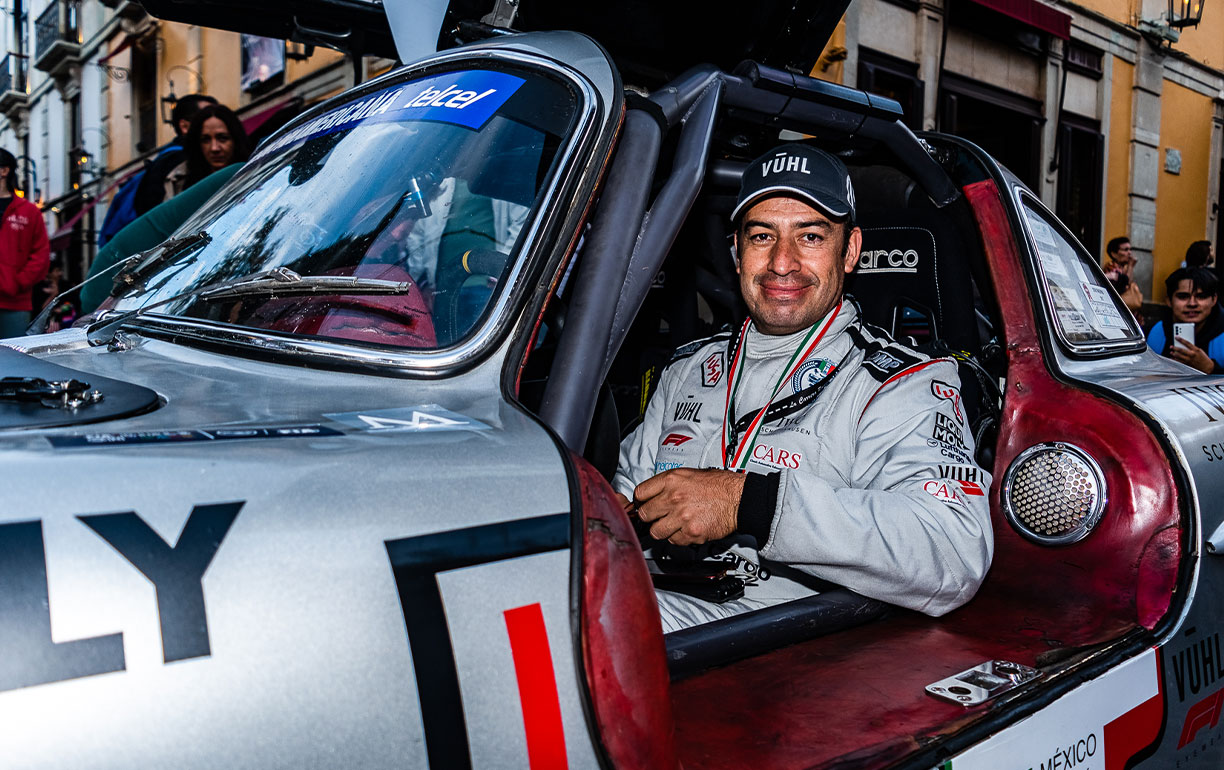
Über die México 150 geht die Fahrt in wilder Hatz Richtung Osten. Zum Glück ist um diese Uhrzeit nicht viel Verkehr. Kurt Richter versucht zu schlafen, aber das ist zwecklos. Zu viele Gedanken jagen ihm durch den Kopf, und über allem die bange Frage: Wird es reichen? Werden sie es wider Erwarten rechtzeitig schaffen? Oder war wirklich alles vergebens? Was, wenn sie irgendwo in einen Stau geraten? Was, wenn wegen des Rennens in Veracruz kein Durchkommen mehr ist? Was, wenn die Rennkommissare nicht mitspielen?
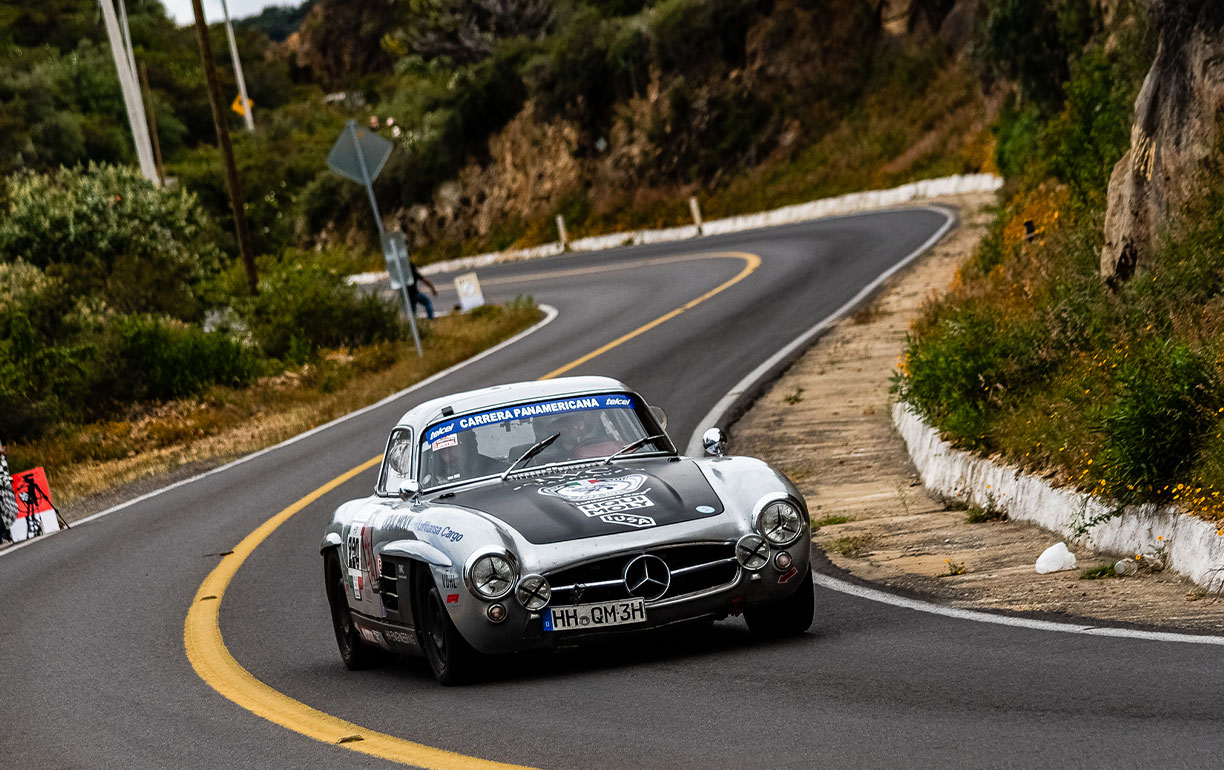
Aber jetzt hat Richter das Glück des Tüchtigen: Sie kommen gut durch und erreichen den Startort um 6.30 Uhr – eine Stunde, bevor es losgehen soll. Und es zeigt sich, dass noch jemand sehnsüchtig auf den 300 SL Flügeltürer gewartet hat: die Rennleitung. Für sie ist das Comeback der Legende zum 70. Jubiläum auch eine echte Herzblut-Angelegenheit. In Windeseile wird der Wagen überprüft und erhält die Startfreigabe.
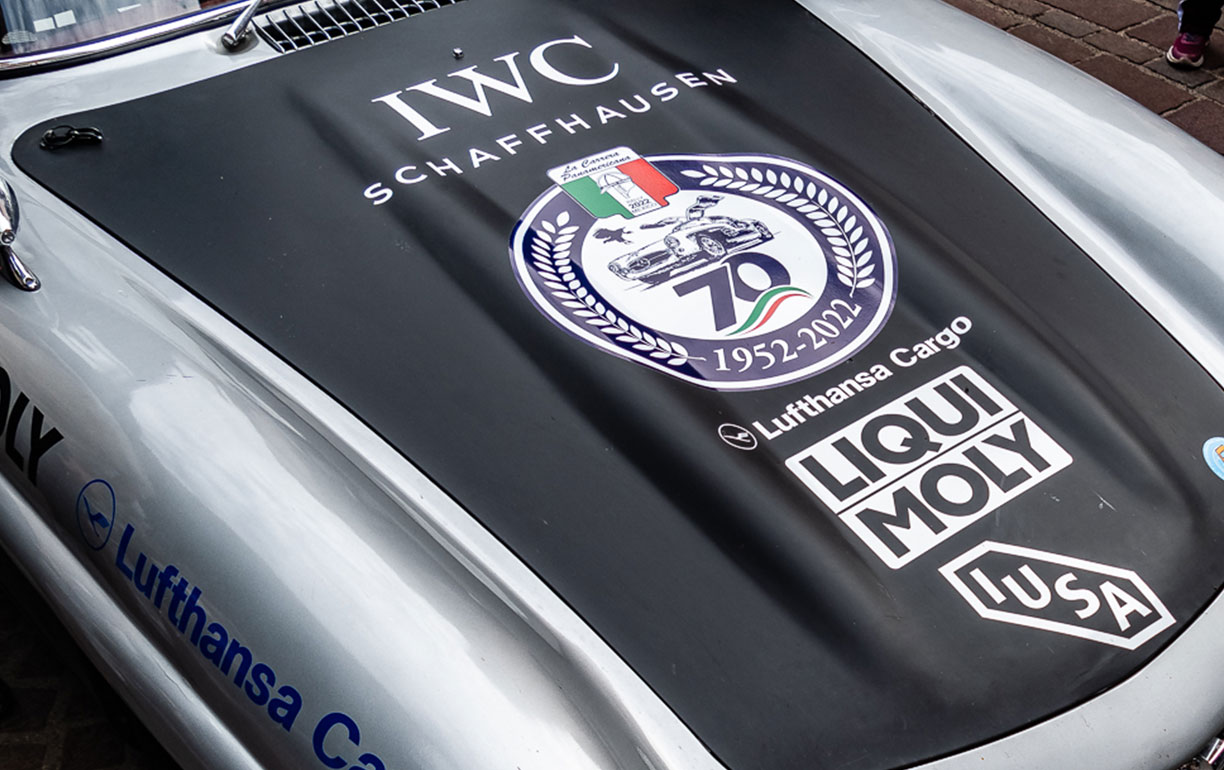
Veracruz, 14. Oktober 2022, 7:29 Uhr. Im Schritttempo rollt ein silberner Mercedes 300 SL Flügeltürer zur Startlinie der 35. Carrera Panamericana. 70 Jahre nach dem legendären Doppelsieg. Zehntausende begeisterte Besucher richten ihre Kameras auf den Wagen. Mit leichtem Antippen des Gaspedals hält Kurt Richter den Motor auf Touren. Kaum gedämpft dringt das heisere Grollen des Sechszylinders durch die seitlichen Schiebefenster an sein Ohr. Auf dem Beifahrersitz hat Ricardo Galindo das Gebetbuch auf den Knien. Eine Hand schiebt sich von links vor die Windschutzscheibe, zählt die letzten Sekunden ab. Vier. Drei. Zwei. Eins. Go. Der Zeiger springt auf 7:30 Uhr. Der Motor heult auf. Der 300 SL schießt wie entfesselt los. Die Legende ist zurück.
"Die Menschen haben den Flügeltürer gesehen – und sie hatten Tränen in den Augen."
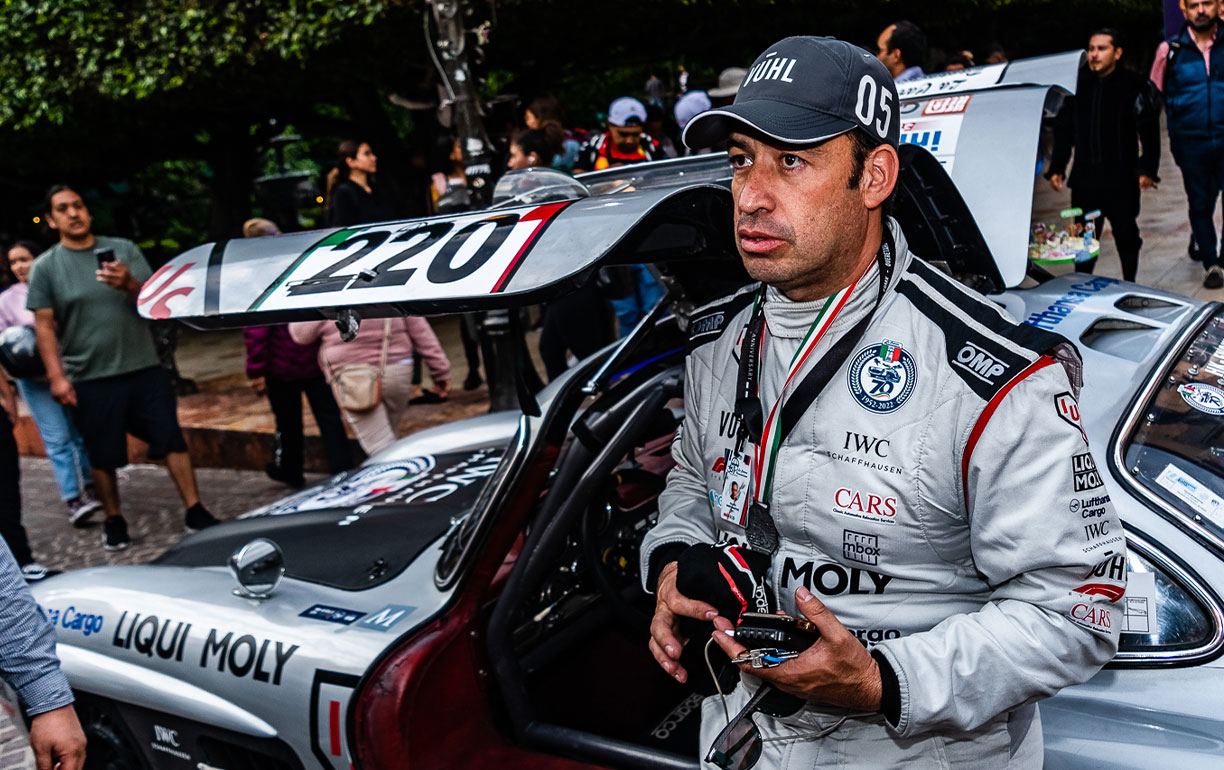
Der Mann
Kurt Richter, Jahrgang 1977
Geboren in Mexiko; die Familie wanderte nach dem Ersten Weltkrieg nach Mexiko aus. Der Vater war Importeur von BMW und Porsche in Mexiko und gab den Auto-Virus an den Sohn weiter. Ursprünglich ausgebildeter KFZ-Mechaniker arbeitet Kurt Richter heute als Event-Consultant und Motorsport-Promotor. Regelmäßig bestreitet er Rennen und Rallyes, vorzugsweise mit historischen Fahrzeugen. Mit der Teilnahme an der Carrera Panamericana im 300 SL Flügeltürer hat sich Richter einen Lebenstraum erfüllt. Die 35. Auflage des Rennens zum 70. Jubiläum des historischen Doppelerfolges von 1952 beendete er als Dritter in seiner Rennklasse.
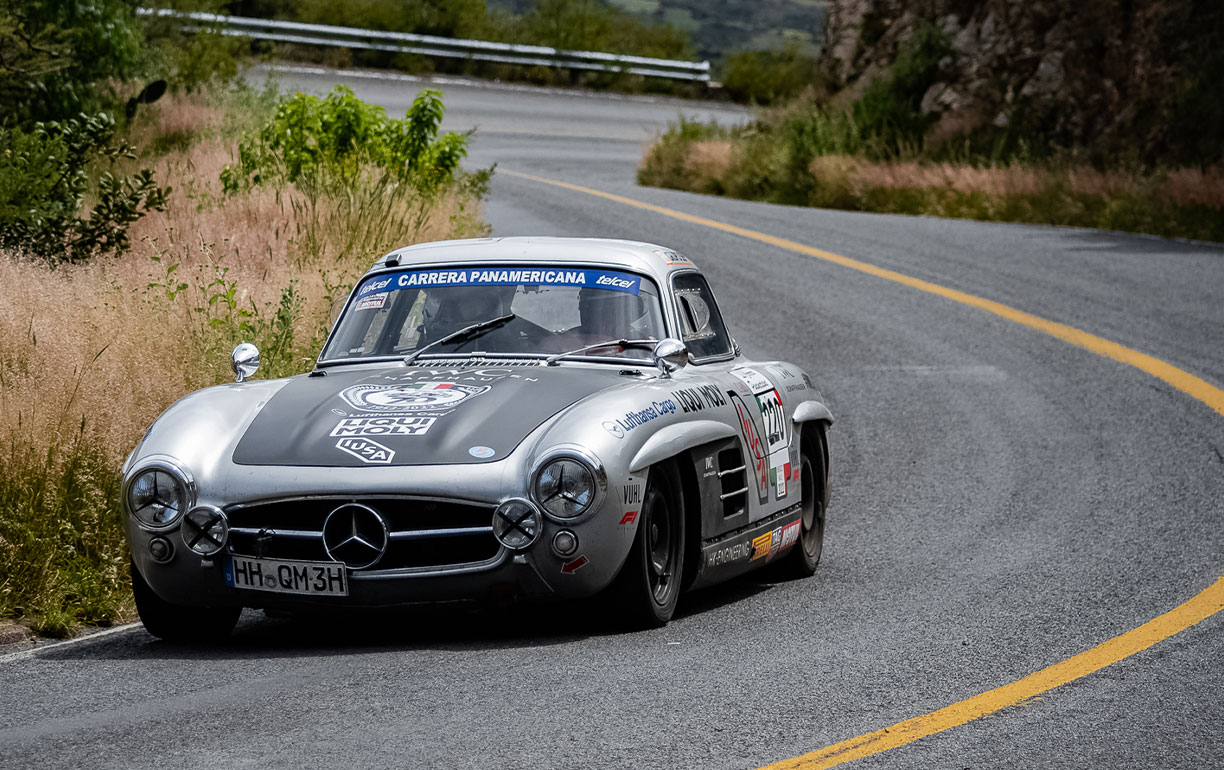
Die Maschine
Mercedes 300 SL (W198) Coupé (Flügeltürer); Straßenversion, umgerüstet auf Rennfahrzeug.
Reihensechszylinder, 3 L Hubraum, 245 PS
Gewicht (im Renntrimm) 1.300 Kilo
Besitzer: Hans Kleissl (HK Engineering)
Das Fahrzeug blickt auf eine lange und erfolgreiche Rennkarriere zurück und ist u.a. regelmäßiger Gast beim Festival of Speed in Goodwood. In der Vergangenheit wurde es von mehreren ehemaligen Formel-1-Fahrern pilotiert, so auch von David Coulthard und Jochen Mass. HK Engineering ist weltweit das einzige Unternehmen, das ausschließlich auf die Wartung, Pflege und Instandsetzung von Mercedes 300 SL spezialisiert ist.
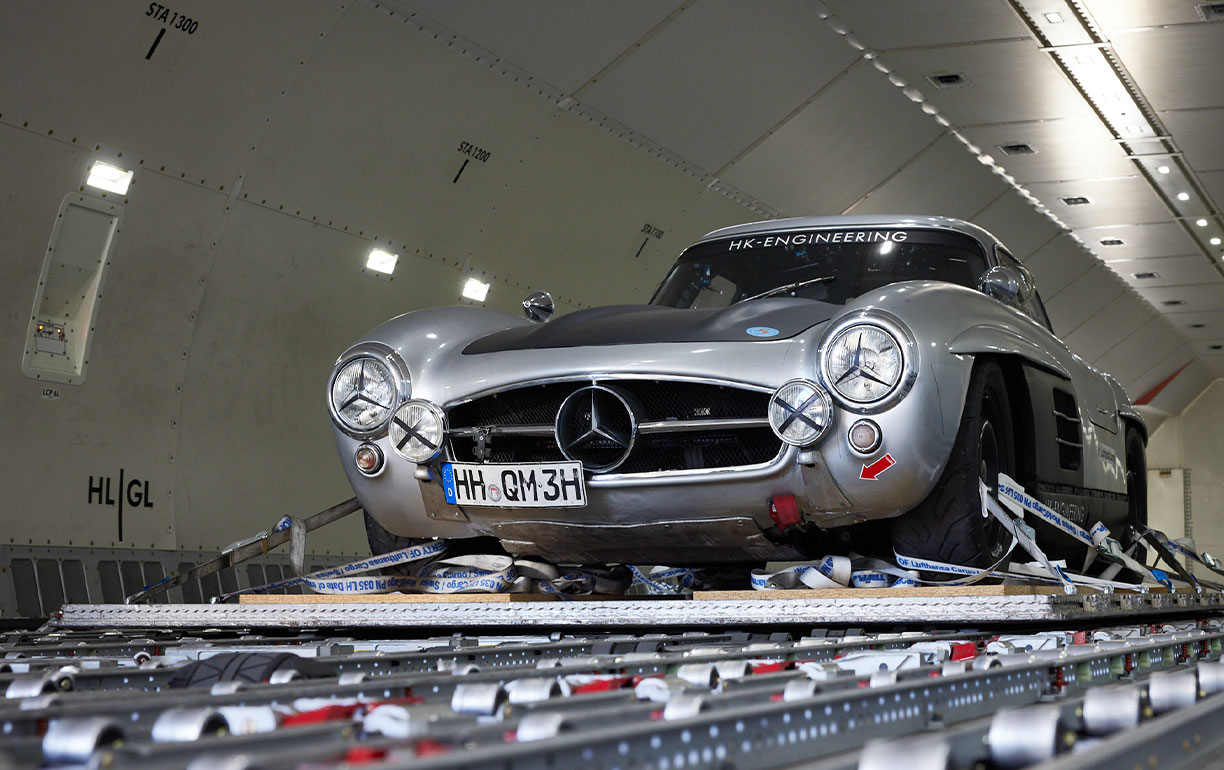
Die Logistik
Lufthansa Cargo td.flash von Frankfurt nach Mexiko City
Bei diesem Projekt kommen gleich drei logistische Herausforderungen zusammen – Termindruck, die Tatsache, dass es sich bei Autos um Dangerous Goods handelt sowie der hohe Wert, was den Flügeltürer gleichzeitig auch zum "Valuable Good" macht. In der Praxis bedeutet das: td.flash ist das Produkt der Wahl, für alles andere heißt es: besonders viel Aufmerksamkeit bis ins letzte Detail. In Sachen Sicherheit erhalten die Schmier- und Betriebsstoffe, die Batterie und auch der Reifendruck besonderes Augenmerk. Außerhalb des Flugzeugs stehen Autos immer in geschützten Bereichen, damit Beschädigungen durch den normalen Lagerbetrieb ausgeschlossen werden können.
|
Oldtimer werden darüber hinaus immer von einem Supervisor begleitet. Auf der Palette selbst gilt dann dasselbe wie auf der Rennpiste: Die perfekte Balance zwischen Bodenhaftung und Dynamik ist Trumpf, damit sich das Auto einerseits bei Luftlöchern nicht selbstständig macht, andererseits aber die starken Kräfte während des Fluges keine Beschädigung der Fahrzeugstruktur verursachen. |
Und wie in vielen anderen professionellen Bereichen zeigt sich auch hier, dass nichts wertvoller ist als jahrelange Erfahrung, vermischt mit Leidenschaft für eine hundertprozentige Performance.
|
